New Account | Seed Mix |
Gift Certificates |AAS Winners |
Gardening Products
SEEDS: Unusual | Annuals | Perennials | Vegetables | Herbs | Trees
Grow Your Own Coffee and Tea Plants From Seeds
For over a thousand more unique seed varieties, all in stock and ready to ship, visit our Seed Catalog Index Page .
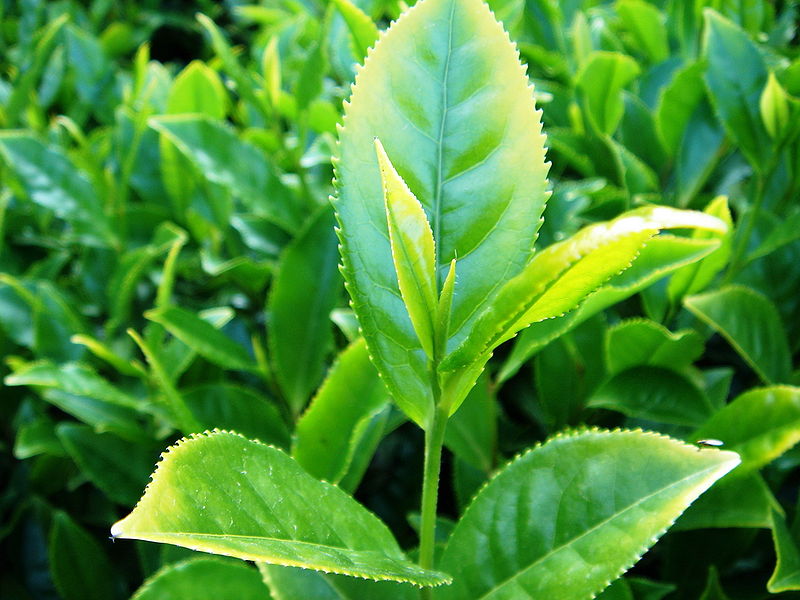
Image: By Karduelis [Public domain], from Wikimedia Commons
AW85 Camellia Tea Plant ( Camellia sinensis )
The tea plant is a small shrub about 3 to 8 feet in height when mature outside, though it will grow taller if you don't prune it. In the fall, your tea shrub will flower with small white blossoms that have a delightful scent. These plants are often grown as ornamentals.
This is the tea produced commercially around the world. The tender, young leaves are used in the process of tea production.
Can be grown in tubs inside, or in cool greenhouses, outdoors in warm climates. Prefers moist, well drained, humus rich, slightly acidic ( 5.5-6.5 )soil. We recommend maintaining a 2-3 inch deep mulch of shredded bark or leaves around base of plant.
Hardy to zone 8, can be grown in zone 7 with protection. To make green tea, pick only the top 3 leaves from new growing tips, spread and dry in the shade for 6-8 hours, then in an open pot, heat ( simmer ) the leaves, stirring frequently for about an hour.
Click here for an informative site on growing and making your own tea. For black tea, you must ferment the leaves. USDA Zones 8 to 11.
This is the tea produced commercially around the world. The tender, young leaves are used in the process of tea production.
Can be grown in tubs inside, or in cool greenhouses, outdoors in warm climates. Prefers moist, well drained, humus rich, slightly acidic ( 5.5-6.5 )soil. We recommend maintaining a 2-3 inch deep mulch of shredded bark or leaves around base of plant.
Hardy to zone 8, can be grown in zone 7 with protection. To make green tea, pick only the top 3 leaves from new growing tips, spread and dry in the shade for 6-8 hours, then in an open pot, heat ( simmer ) the leaves, stirring frequently for about an hour.
Click here for an informative site on growing and making your own tea. For black tea, you must ferment the leaves. USDA Zones 8 to 11.
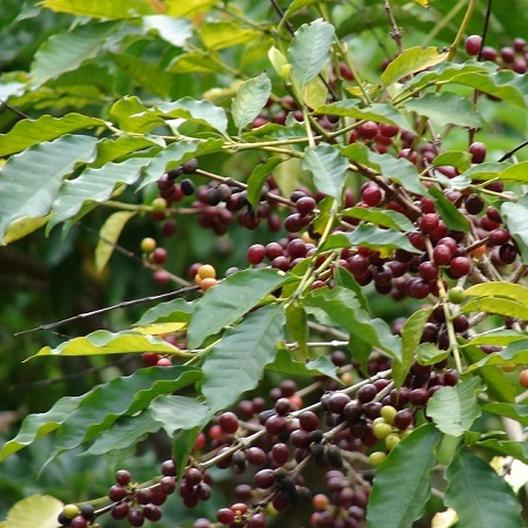
TRZ159 Kona Coffee ( Coffee Arabica )
The Kona is the very popular coffee of Hawaii. Its a heavy bearing variety with excellent quality. Normally it begins to produce in 4 years. One producing tree can provide 1 lb. of coffee. Can be grown in bright light indoors, outside in zone 10 and higher.
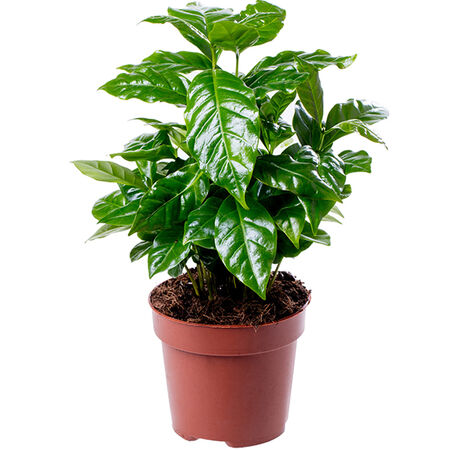
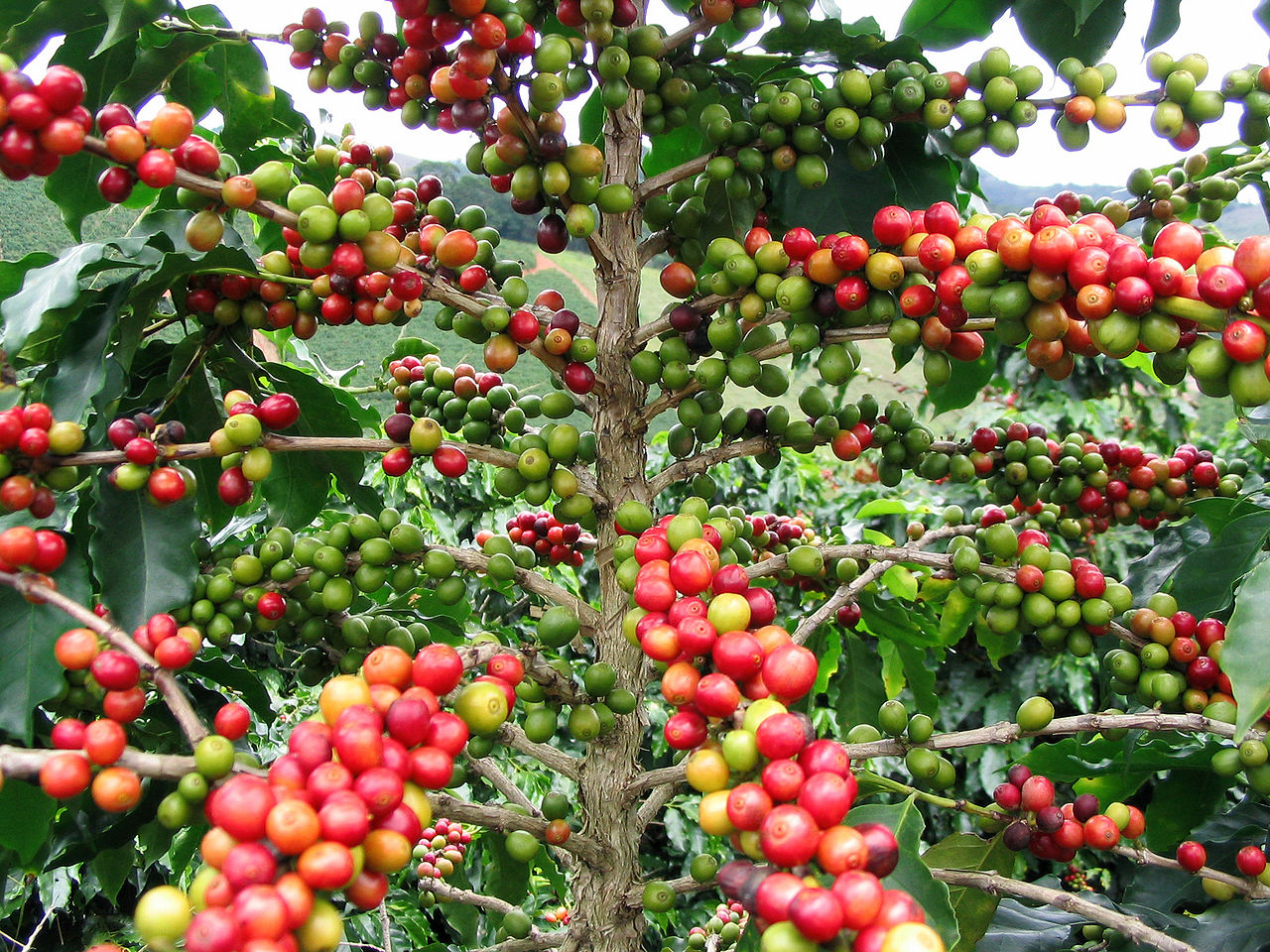
D4503 Coffee Plant ( Coffea Arabica )
Coffee can be grown outdoors in some parts of the US, but is often grown in pots. The world's most important trade crop also makes a wonderful house plant. Click here for info on growing your coffee plant inside. The plants have dark shiny-green leaves and whitefragrant flowers. A very ornamental plant. Very unique.
Considered to be among the easiest and hardiest of houseplants, coffee plant is great for both experienced and beginner gardeners. Not only is coffee plant care easy, but the plant itself is lovely and makes a wonderful addition to the home. Coffee plants prefer bright, but indirect, light. This means that they should be placed near a window but not directly in the window itself. They also cannot take temperatures below freezing and will not do well in temperatures that stay consistently below 65 degrees. Keep them away from drafts in the winter. When growing coffee plants, the soil needs to stay moist, but not soaking wet.
Also, make sure that both the soil and the pot your coffee plant is growing in has good drainage. The humidity around the plant will need to stay high as well. Setting your coffee plant on a water-filled pebble tray will help with humidity. Like many houseplants, a coffee plant will need less water in the winter than in the summer.
Plant coffee plants in a rich, peat-based potting soil with excellent drainage. Coffee plants prefer acidic soil, so if your plant is not thriving add organic matter such as sphagnum peat moss to increase soil pH. Coffee plants can grow in soil with a pH range of 4 to 7 but the ideal pH range is closer to 6 to 6.5.
Considered to be among the easiest and hardiest of houseplants, coffee plant is great for both experienced and beginner gardeners. Not only is coffee plant care easy, but the plant itself is lovely and makes a wonderful addition to the home. Coffee plants prefer bright, but indirect, light. This means that they should be placed near a window but not directly in the window itself. They also cannot take temperatures below freezing and will not do well in temperatures that stay consistently below 65 degrees. Keep them away from drafts in the winter. When growing coffee plants, the soil needs to stay moist, but not soaking wet.
Also, make sure that both the soil and the pot your coffee plant is growing in has good drainage. The humidity around the plant will need to stay high as well. Setting your coffee plant on a water-filled pebble tray will help with humidity. Like many houseplants, a coffee plant will need less water in the winter than in the summer.
Plant coffee plants in a rich, peat-based potting soil with excellent drainage. Coffee plants prefer acidic soil, so if your plant is not thriving add organic matter such as sphagnum peat moss to increase soil pH. Coffee plants can grow in soil with a pH range of 4 to 7 but the ideal pH range is closer to 6 to 6.5.
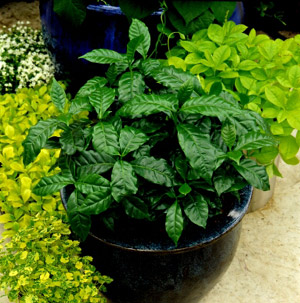
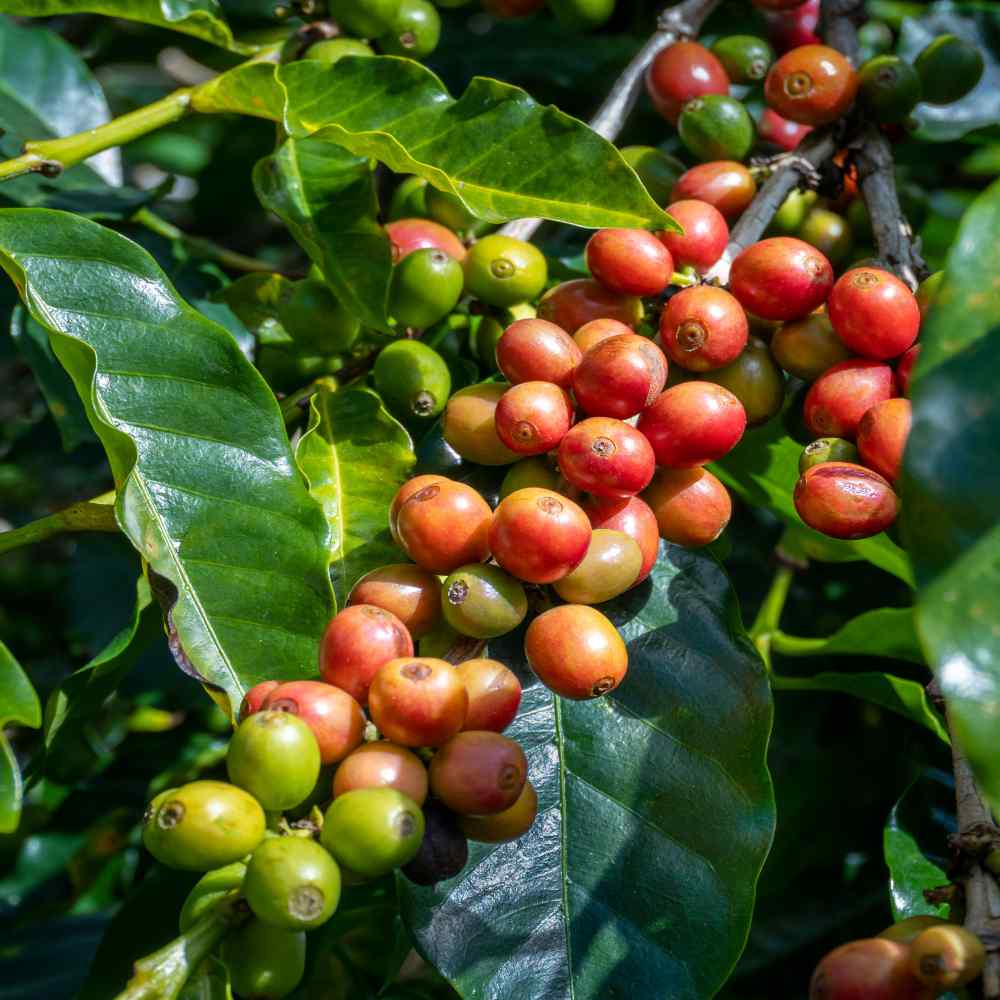
TRZ140 Arabica Nana Coffee ( Coffee Arabica Nana )
Wouldn't it be nice to grow your own coffee house plant from coffee seeds? Coffea arabica nana is a dwarf bush with beans that contain caffeine, theophylline and theobromine. The beans are dried, roasted and ground, and then extracted with water to produce coffee. Coffea arabica is a species of coffee bush that produces arabica coffee, accounting for the majority of the coffee consumed in the world. This species of bush is the oldest known bush to be cultivated for coffee production. Until the beginning of the 20th century, it was virtually the only type of tree from which coffee was harvested commercially.
The Coffea Arabica plant produces star-shaped, sweetly scented white flowers. These flowers are followed by green fruits which change to red then to almost black as they ripen, a process that takes several months. Inside each ripened fruit are 2 seeds (or beans) that when properly roasted can be ground and made into coffee.
Growing coffee plants indoors from Coffea Arabica seeds is easy. They are vigorous growers and are long-lived. Coffea Arabica plants are very attractive. Just don't expect them to offer that morning cup of joe as the coffee plants as well as coffee seeds take some patience, and it could take a few years before you see many fruits on it.
The Coffee plant is usually about 1 foot in height at the time of purchase from a nursery, but can reach a height of about 5 feet, growing 12 inches per year. If a smaller plant is preferred, the dwarf version, Coffea arabica nana, which is what we offer, remains much smaller and grows at a slower rate normally only reaching about 18" tall. Can be grown in bright light indoors, outside in zone 10 and higher.
The Coffea Arabica plant produces star-shaped, sweetly scented white flowers. These flowers are followed by green fruits which change to red then to almost black as they ripen, a process that takes several months. Inside each ripened fruit are 2 seeds (or beans) that when properly roasted can be ground and made into coffee.
Growing coffee plants indoors from Coffea Arabica seeds is easy. They are vigorous growers and are long-lived. Coffea Arabica plants are very attractive. Just don't expect them to offer that morning cup of joe as the coffee plants as well as coffee seeds take some patience, and it could take a few years before you see many fruits on it.
The Coffee plant is usually about 1 foot in height at the time of purchase from a nursery, but can reach a height of about 5 feet, growing 12 inches per year. If a smaller plant is preferred, the dwarf version, Coffea arabica nana, which is what we offer, remains much smaller and grows at a slower rate normally only reaching about 18" tall. Can be grown in bright light indoors, outside in zone 10 and higher.

3338 Yerba Mate ( Ilex paraguayensis )
Yerba Mate makes a good houseplant that provides leaves for tea. Click here for an informative site on growing yerba mate indoors.
Grow you own Yerba Mate and enjoy this popular South American tea as an alternative beverage to coffee. In Latin America, Yerba Mate is the beverage of choice and has a smoother taste than green tea, plus it's loaded with antioxidants. The plant itself makes a wonderful potted plant for its graceful full-leafed branches. Under warm temperatures, it grows throughout the year, even in the north as a potted plant with flowers arriving during the winter/spring months. The leaves can be harvested once the plant is established. Grow in full sun with temperature above 65 degrees for fastest growth.
Hardy to Zone 10 and higher for outdoors.
Yerba mate was has been used as a beverage since the time of the ancient Indians of Brazil and Paraguay. In the early 16th century, Juan de Solis, a Spanish explorer of South America's famed La Plata River, reported that the Guarani Indians of Paraguay brewed a leaf tea that "produced exhilaration and relief from fatigue." The Spaniards tried the beverage and liked it. Their subsequent demand for the tea led the Jesuits to develop plantations of the wild species in Paraguay and yerba mate became known as "Jesuits' tea" or "Paraguay tea."
Methods of leaf preparation for the traditional tea beverage vary then and now: in one method, the branches are cut, then held over an open fire (to fire-cure the leaves). This deactivates the enzymes in the leaves (making them more brittle) and the green color of the leaves is retained in the subsequent drying process (with charred bits often found in the resulting tea product, which lends to a smoky flavor). Other methods include a brief par-blanching of the leaves in boiling water (to deactivate the leaf enzymes and soften its leathery texture). They then are toasted dry in large pans over a fire or inside a brick oven-resulting in a finished brown-leaf tea.
The wild plant has a distinct aroma and taste that has not been matched by plantation cultivation. In South America yerba mate is considered a national drink in several countries; in Europe, it is called "the green gold of the Indios." In Brazil and Paraguay (leading exporters of mate), some production still comes from wild stands-most of which is found in the humid depressions of the foothills. It is not unusual for one wild tree to yield 30-40 kg of dried leaves annually. In wild harvesting, mate gatherers, called tarrafeiros or yebateros, travel through the jungle searching for a stand of trees (called a mancha). Harvesting is done between May and October, when the tree is in full leaf. Leaves are picked from the same tree only every third year, which protects it for subsequent crops. Most of the mate in commerce today, however, comes from large cultivation projects in Paraguay and Uruguay.
The word mate is Spanish for "gourd," and refers to the small gourd cup in which the tea beverage traditionally is served throughout South America. It is also served with a metal drinking straw or tube, called a bombilla, which has a filter attached to the lower end to strain out leaf fragments. The bottom third of the gourd is filled with fire-burned or toasted leaves, and hot water is added. Burnt sugar, lemon juice, and/or milk often is used to flavor the refreshing tea, which occupies a position rivaling that of coffee in the United States. Mate bars are as prevalent in South America as coffee bars are in North America and Europe; mate drinking has deep cultural roots.
In addition to its standing as a popular beverage, yerba mate is used as a tonic, diuretic, and as a stimulant to reduce fatigue, suppress appetite, and aid gastric function in herbal medicine systems throughout South America. It also has been used as a depurative (to promote cleansing and excretion of waste). In Brazil, mate is said to stimulate the nervous and muscular systems and is used for digestive problems, renal colic, nerve pain, depression, fatigue, and obesity. A poultice of the leaves also is applied topically to anthrax skin ulcers (for which mate's tannin content - highly astringent - may be the reasoning behind this use).
Grow you own Yerba Mate and enjoy this popular South American tea as an alternative beverage to coffee. In Latin America, Yerba Mate is the beverage of choice and has a smoother taste than green tea, plus it's loaded with antioxidants. The plant itself makes a wonderful potted plant for its graceful full-leafed branches. Under warm temperatures, it grows throughout the year, even in the north as a potted plant with flowers arriving during the winter/spring months. The leaves can be harvested once the plant is established. Grow in full sun with temperature above 65 degrees for fastest growth.
Hardy to Zone 10 and higher for outdoors.
Yerba mate was has been used as a beverage since the time of the ancient Indians of Brazil and Paraguay. In the early 16th century, Juan de Solis, a Spanish explorer of South America's famed La Plata River, reported that the Guarani Indians of Paraguay brewed a leaf tea that "produced exhilaration and relief from fatigue." The Spaniards tried the beverage and liked it. Their subsequent demand for the tea led the Jesuits to develop plantations of the wild species in Paraguay and yerba mate became known as "Jesuits' tea" or "Paraguay tea."
Methods of leaf preparation for the traditional tea beverage vary then and now: in one method, the branches are cut, then held over an open fire (to fire-cure the leaves). This deactivates the enzymes in the leaves (making them more brittle) and the green color of the leaves is retained in the subsequent drying process (with charred bits often found in the resulting tea product, which lends to a smoky flavor). Other methods include a brief par-blanching of the leaves in boiling water (to deactivate the leaf enzymes and soften its leathery texture). They then are toasted dry in large pans over a fire or inside a brick oven-resulting in a finished brown-leaf tea.
The wild plant has a distinct aroma and taste that has not been matched by plantation cultivation. In South America yerba mate is considered a national drink in several countries; in Europe, it is called "the green gold of the Indios." In Brazil and Paraguay (leading exporters of mate), some production still comes from wild stands-most of which is found in the humid depressions of the foothills. It is not unusual for one wild tree to yield 30-40 kg of dried leaves annually. In wild harvesting, mate gatherers, called tarrafeiros or yebateros, travel through the jungle searching for a stand of trees (called a mancha). Harvesting is done between May and October, when the tree is in full leaf. Leaves are picked from the same tree only every third year, which protects it for subsequent crops. Most of the mate in commerce today, however, comes from large cultivation projects in Paraguay and Uruguay.
The word mate is Spanish for "gourd," and refers to the small gourd cup in which the tea beverage traditionally is served throughout South America. It is also served with a metal drinking straw or tube, called a bombilla, which has a filter attached to the lower end to strain out leaf fragments. The bottom third of the gourd is filled with fire-burned or toasted leaves, and hot water is added. Burnt sugar, lemon juice, and/or milk often is used to flavor the refreshing tea, which occupies a position rivaling that of coffee in the United States. Mate bars are as prevalent in South America as coffee bars are in North America and Europe; mate drinking has deep cultural roots.
In addition to its standing as a popular beverage, yerba mate is used as a tonic, diuretic, and as a stimulant to reduce fatigue, suppress appetite, and aid gastric function in herbal medicine systems throughout South America. It also has been used as a depurative (to promote cleansing and excretion of waste). In Brazil, mate is said to stimulate the nervous and muscular systems and is used for digestive problems, renal colic, nerve pain, depression, fatigue, and obesity. A poultice of the leaves also is applied topically to anthrax skin ulcers (for which mate's tannin content - highly astringent - may be the reasoning behind this use).
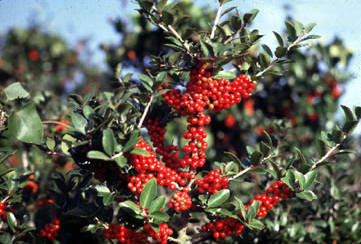
TRZ158 Yaupon Holly ( Ilex vomitoria )
Looking for a lovely and useful plant for your garden? Consider the Ilex vomitoria! Also known as yaupon holly, yaupon, or cassina, this species of holly is native to southeastern North America, from Maryland to Florida and Texas. It boasts smooth, gray bark and glossy dark green leaves, and produces beautiful quarter-inch scarlet fruit in large quantities. The plant takes well to pruning and is adaptable to various soil types.
The leaves are small, leathery and bright green and are not prickly like other hollies. The flowers attract bees and butterflies. This holly can rapidly reach 10 to 20 feet tall and 8 to 12 feet wide, so allow proper spacing when planting multiples. It will form thickets unless the suckers are removed.
Though occasionally used for hedging, it is primarily used for landscaping. The wood of the Ilex vomitoria is heavy and hard, making it useful for turnery, inlay work, and other woodenware. The plant is also culturally significant: Native Americans used the leaves and stems to make a tea containing caffeine, a unique quality in a North American plant. Rediscovered in modern times, yaupon tea made from dried leaves is now commercially available. Add this picturesque and useful plant to your garden today!
Grow as a container plant or outside in zones 7-9.
The leaves are small, leathery and bright green and are not prickly like other hollies. The flowers attract bees and butterflies. This holly can rapidly reach 10 to 20 feet tall and 8 to 12 feet wide, so allow proper spacing when planting multiples. It will form thickets unless the suckers are removed.
Though occasionally used for hedging, it is primarily used for landscaping. The wood of the Ilex vomitoria is heavy and hard, making it useful for turnery, inlay work, and other woodenware. The plant is also culturally significant: Native Americans used the leaves and stems to make a tea containing caffeine, a unique quality in a North American plant. Rediscovered in modern times, yaupon tea made from dried leaves is now commercially available. Add this picturesque and useful plant to your garden today!
Grow as a container plant or outside in zones 7-9.

